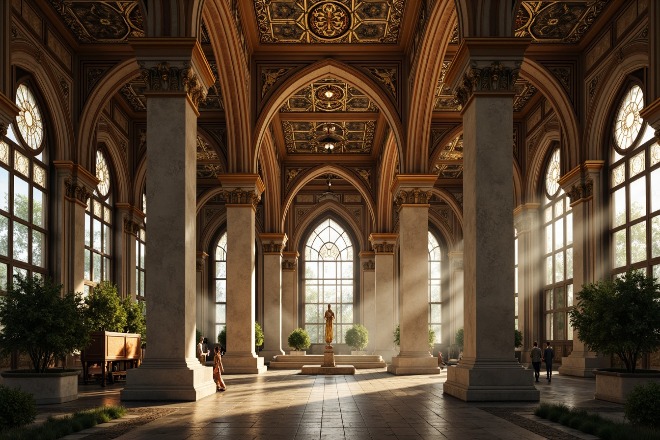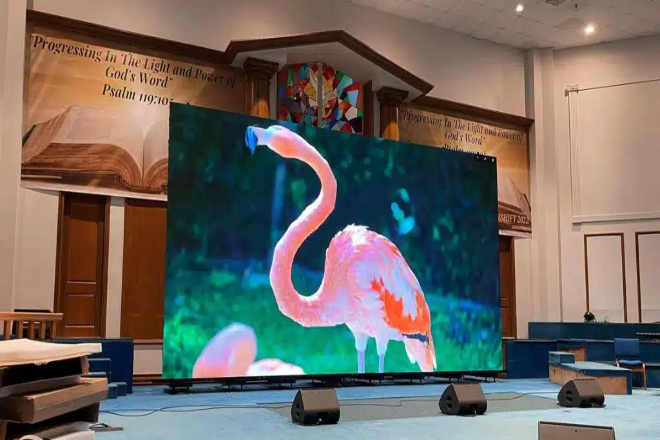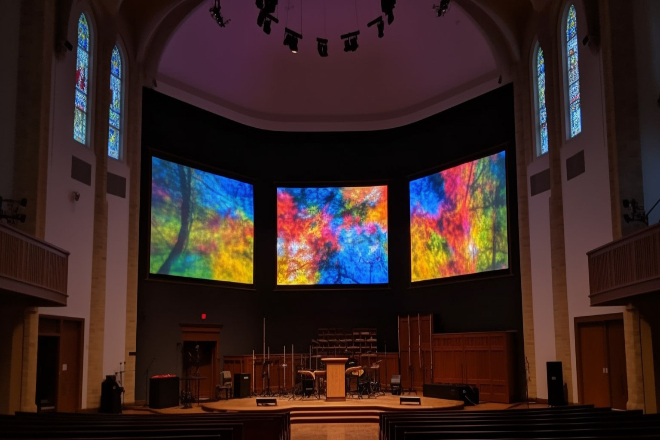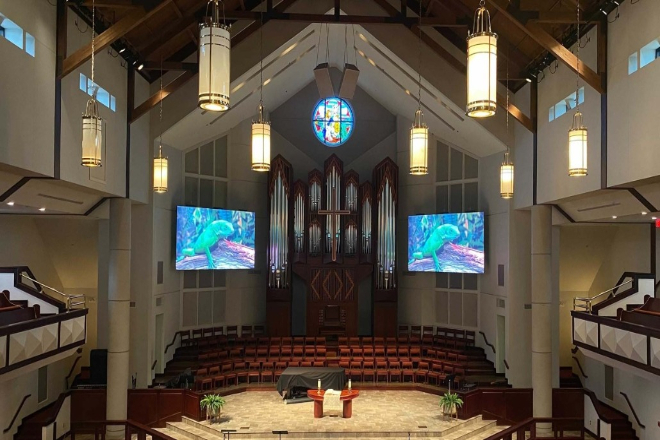소개
In today’s digital age, the integration of technology and tradition has become a trend.
However, when modern LED 디스플레이 enter solemn religious places, we can’t help but ask: How can we integrate LED displays perfectly into them while maintaining the sacred atmosphere of religious places?
This article will talk about this topic in detail.
목차
1. Analysis of the aesthetic characteristics of religious places

The spatial design of religious places is very particular, just to make people feel different as soon as they enter.
For example, the tall dome of the church, looking up, has a towering feeling that seems to bring people’s hearts to the sky, making people feel much closer to heaven.
The main hall of the temple is also very particular, with a large space and a symmetrical layout.
The Buddha statue is in the middle, and the two sides are neatly arranged, giving people a very solemn feeling.
Moreover, light is also very important. The stained glass in the church, when the sun shines, colorful light and shadows are sprinkled on the ground, which is particularly dreamy.
The soft light in the temple, coupled with the smoke, is also very atmospheric.
These designs are to make believers feel a sense of sacredness beyond daily life.
The colors and materials of religious places are very particular. Churches often use gold, which is glittering and looks particularly gorgeous and also symbolizes sacredness and dignity.
The red color commonly seen in temples looks very festive and also represents auspiciousness and solemnity. Materials are also critical.
The church uses stone, which is hard and strong, giving people a very stable feeling, as if the building can stand for a thousand years.
The temple uses wood, which feels warm and natural. These colors and materials not only make religious places look beautiful but also make people feel a special atmosphere through their characteristics.
The decorative art in religious places, such as sculptures, murals, and stained glass, are all very interesting. The sculptures in the church, such as the Virgin Mary holding Jesus, are very touching.
The murals are also wonderful, such as “Genesis” and “The Last Judgment,” which are large and detailed, showing all religious stories.
The Buddha statues in the temples are also very charming, and the expressions of the Buddha statues are very peaceful, which makes people feel calm when they see them.
These decorative arts are not only beautiful but also carry many religious stories and cultural connotations so that believers can also have a deeper understanding of religious culture when appreciating them.
2. Analysis of the aesthetic characteristics of LED display screens

1). Visual impact and dynamic performance
The LED display screen is like a super cool “light and shadow magician”. The 명도 is so high that it can illuminate the picture brightly, and the contrast is also very strong, the black is blacker, and the white is whiter, which is very comfortable to watch.
This high brightness and high contrast picture can catch people’s eyes at once, whether it is day or night.
Moreover, it can also play various dynamic content, such as videos and animations. When the picture moves, the vitality and vividness are completely incomparable to static pictures.
예를 들어, 쇼핑몰, those LED screens that play advertisements, once the picture moves, passers-by can’t take their eyes away.
Dynamic content can not only attract people, but also make it easier for people to remember the information on it. This visual impact is really amazing!
2). Modern expression of color and light
The LED display is simply a “master” in color. It can present super rich colors, from the brightest red to the deepest blue, and it can be easily handled.
And the color saturation is particularly high, it looks very comfortable and not dazzling at all. This ability to express colors makes the picture look very real, just like what is in front of you.
Moreover, LED displays can also play a variety of light effects, such as flashing and gradient, which can be adjusted as needed.
For example, on the 단계, the flashing lights can instantly ignite the atmosphere of the scene.
On the advertising screen, the gradient color can make the picture look more layered.
The combination of these light effects and colors makes LED displays particularly popular in modern aesthetics, which can create a variety of different atmospheres and feelings.
3). Content diversity and variability
The content of the LED display is super flexible; you can put whatever you want! It can display text, such as scrolling news headlines or advertising slogans.
It can also display pictures, such as exquisite product posters; it can also play videos, such as movie trailers or live broadcasts of events.
This diverse display method makes it particularly efficient in conveying information. Whether it is to quickly convey important information or to display complex content, it can be easily handled.
Moreover, its content can be changed at any time, just like a “variable big shot.” For example, at religious activities, animations of religious stories can be played; at festivals and celebrations, lively celebration videos can be displayed.
This variability makes it very useful on various occasions. It can be changed as you want, which is very convenient!
3. The manifestation of the aesthetic conflict between religious places and LED display screens

1). Differences in visual styles
Religious places are usually places that make people feel particularly peaceful and solemn, such as 교회 and temples.
Their decoration styles are mostly traditional, with soft colors and a peaceful overall atmosphere.
But LED display screens are different. It is a very modern thing. The picture moves around, flickers constantly, and the colors are also bright.
This modern and dynamic visual style is put together with the traditional and solemn style of religious places, which can easily make people feel inconsistent.
For example, a flashing LED screen suddenly appears in a quiet church, and the quiet atmosphere is broken, which makes people feel very abrupt.
2). Mismatch between color and light
The light in religious places is mostly soft, and natural light pours in through the windows, giving people a warm and peaceful feeling. However, the LED display is different; it has high brightness and strong colors.
If the LED display is placed in a religious place, the strong light and bright colors will form a sharp contrast with the soft light in the religious place, making people feel very dazzling.
This mismatch will not only destroy the overall beauty of the religious place but also make people feel uncomfortable and affect people’s awe of religious places.
3). Conflict between content and religious culture
Religious places are sacred places, and everything in them should be consistent with religious culture.
But LED display screens sometimes display some secular content, such as advertisements and entertainment information, which are completely incompatible with the sacredness of religious places.
For example, seeing an advertisement scrolling on the LED screen in a temple, this improper choice of content will make people feel very inappropriate and even impact the cultural value of religious places.
The atmosphere of religious places should make people feel peaceful and awe-inspiring rather than being disturbed by secular content.
4. Design principles for achieving compatibility between LED display and religious aesthetics

1). Respect for tradition and integration with modernity
When using LED display in religious places, special attention should be paid to respecting tradition.
The atmosphere of religious places is usually quiet and solemn, such as the stained glass in the church and the wooden Buddha statues in the temple, which are all manifestations of traditional aesthetics.
Therefore, when introducing LED display, it should not destroy this atmosphere. We can design LED display to be low-key.
For example, choose a less fancy frame or embed the screen into the wall so that it looks like part of the religious place rather than an abrupt foreign object.
At the same time, we can also take advantage of the modern technology of LED display screens, such as using it to display animations of religious stories or play religious music.
This preserves both traditional and modern elements, making tradition and modernity harmonious and unified.
2). Coordinated design of color and light
The light and color of religious places are usually soft, such as the colorful light and shadow cast through the stained glass in the church and the warm yellow light in the temple.
If the color and light effect of the LED display are too strong, it will appear very abrupt.
Therefore, we need to adjust the color and light effect of the LED display to make it coordinated with the overall atmosphere of the religious site.
For example, the brightness of the LED display can be lowered a little, the color can be adjusted to be softer, and avoid using colors that are too bright or dazzling.
At the same time, the color of the LED display can also be matched with the decorative color of the religious site through color calibration technology.
For light effects, try to reduce flickering and fast-changing light effects, and choose some peaceful and gradual light effects.
So that the modern sense of the LED display can be retained without destroying the tranquil atmosphere of the religious site.
3). The fit between content and religious culture
Religious sites are sacred places, so the content displayed on the LED display must be consistent with religious culture.
You cannot put some advertisements or entertainment content that is not related to religion, which will make people feel very inappropriate.
We can use LED displays to display religious stories, doctrine explanations, religious ritual processes, and other content, which not only conforms to the sacredness of religious sites but also plays a role in educating and spreading religious culture.
In the design of content, we should pay attention to the solemnity and beauty of the picture, and avoid overly fancy or exaggerated animation effects.
At the same time, a content review mechanism can also be set up to ensure that each displayed content meets the requirements of religious places.
So that LED display screens can truly become a good helper for the dissemination of religious culture.
5. 결론
Through the discussion in this article, we have seen the possibility of aesthetic compatibility between religious places and LED display screens.
However, how to truly achieve this goal requires more practice and thinking. I hope this article can inspire you.
마지막으로 LED 디스플레이 화면에 대해 더 알고 싶다면, 우리에게 연락해주세요.
